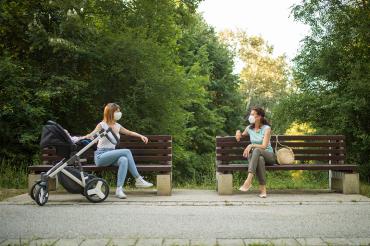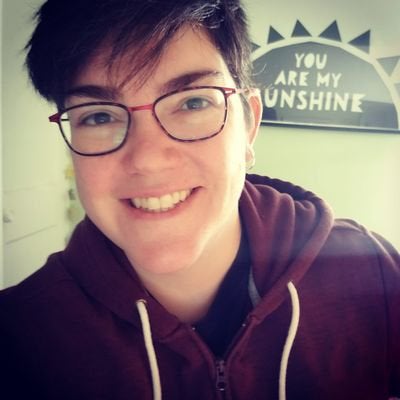Social connection: How talking with friends and neighbours can boost mental health

Published: March 15, 2021
If pandemic restrictions are making you feel lonely or isolated, calling a friend – or simply checking in on someone – may help lift your mood.
Research shows social connections are critical for our mental health and, sometimes, just the sound of a familiar voice can help.
 Kate Mulligan, an assistant professor of social and behavioural sciences at U of T’s Dalla Lana School of Public Health, says she has long advocated for social connection as a crucial component of people’s mental health and overall wellbeing.
Kate Mulligan, an assistant professor of social and behavioural sciences at U of T’s Dalla Lana School of Public Health, says she has long advocated for social connection as a crucial component of people’s mental health and overall wellbeing.
That can take the form of an “old-fashioned phone call while walking outside, or doing an online jigsaw puzzle with someone else, or a distanced visit outside with neighbours,” she says.
Mulligan previously served as director of policy and communications at the Alliance for Healthier Communities, a network of community-governed primary health-care organizations. The network integrates prescriptions for social connection into existing health care and community services.
Working with 11 community health centres from 2018 to 2019, the Alliance for Healthier Communities conducted Canada’s first social prescribing research pilot, dubbed Rx: Community. They found that “social prescriptions” – personalized referrals to local, non-clinical services that range from gardening to singing groups – contributed to a reported 12 per cent improvement in mental health and a reported 49 per cent decrease in loneliness among participating clinics.
In a recent conversation with U of T News, Mulligan spoke about the impact of loneliness on mental health and the benefits of sustained social connection.
How important is social interaction? What are some of the health benefits, both physical and psychological?
Social connection is fundamental to our health and overall wellbeing because we are social creatures. There are some immediate benefits of being together: Those who are part of a connected community tend to eat healthier; they’re less likely to smoke and more likely to take up physical activities; and they’re more likely generally to take part in healthy behaviours.
Loneliness, on the other hand, has significant health impacts that are on par with the consequences of diabetes and heart disease in terms of effects on the cardiovascular system.
What kind of impact do the physical distancing measures taken to combat COVID-19 have on our mental health?
Being isolated and disconnected for a full year, on and off, can be profoundly stressful. This is particularly true for people who are facing existing barriers and who have been excluded from making decisions in society, such as Indigenous people, Black and racialized people, LGBTQ people. These groups have been disproportionately impacted by isolation because of historical exclusion.
Surveys by the Angus Reid Institute, an independent research non-profit, have illustrated the differences in how we are feeling about being alone. (For instance, one survey in October of last year found that those earning household incomes of less than $50,000 were more likely to be experiencing isolation than wealthier Canadians, though the proportion of isolated individuals has increased across income levels.)
How does social prescribing work?
Social prescribing is a way to bring together health and social services in an integrative way.
Maybe you keep coming to the doctor’s office even though there is nothing they can do for you in a clinical way. A health-care provider within the social prescribing network can connect you with a worker who takes the time to listen to you and reframe the conversation. After getting to know you, they might recommend a singing group, gardening or something more concrete like an offer of food or housing. The worker is someone who has the capacity to listen or maybe even partake in the activities with you. They could be a volunteer, a community health centre worker, a social worker – someone who knows what is available in the local community.
More and more clinicians are seeing the value of doing this work, and they are seeing results on par with biomedical interventions.
What are some ways for people to stay connected right now while adhering to public health guidelines?
Getting outside in nature is a big one, because we are connected to our environments and our ecologies, not just to other humans. When we go outside, we are also likely to see other people and rebuild some of those weak ties that have been most broken during COVID – those spontaneous interactions with strangers that we used to incidentally see every day.
But we don’t want the interaction to be another thing on our to-do list. Sometimes there is pressure on us to be social, and we are all a little tired of maintaining a smile on Zoom. Maybe a good old-fashioned phone call while walking outside, or doing an online jigsaw puzzle with someone else, or a distanced visit outside with neighbours, can take a bit of the pressure off.
We should also be forgiving of ourselves if we don’t feel like doing all that social stuff right now.
The people who have reported the biggest benefits from social prescribing were those who volunteered and gave back to their communities. When you have that shift from thinking of yourself as someone with a deficit or a loss to someone with something to offer, that’s valuable. Doing some spring clean-ups or virtual outreach are all ways to make you feel part of the community.
Here are a few ways to stay connected at U of T and beyond:
U of T’s Access & Inclusion Peer Programs: A mentorship program for students from historically underrepresented and marginalized communities. Mentor navigators are upper-year students who identify as being from underrepresented communities and are available to meet online or over the phone during COVID-19.
U of T’s Hart House Study with Me!: Join fellow students for a virtual drop-in, student-led study session on Tuesdays and Thursdays. “Productivity with purpose is just a couple clicks away!”
QuarantineChat: The app Dialup places you on a call with a random person who could be anywhere in the world. The project aims to “simulate the magic of having a surprise conversation with someone – something that is becoming increasingly rare during the times of a viral epidemic.”
Stuck at Home (Together) Creativity Challenges: Creative challenges that include photography, writing and art that you can share with others online through The UnLonely Project.
Be My Eyes: Through this free app, sighted volunteers can be connected with blind and low-vision people to provide visual assistance through a live video call.



